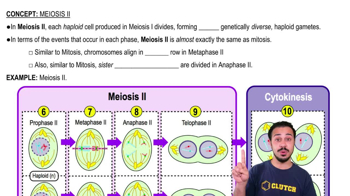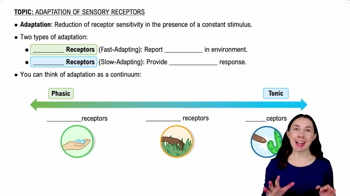Fill in the blanks: At the end of meiosis, each cell has ________ chromosomes and they are genetically ________ from the original cell.
Ch. 26 The Reproductive System
Chapter 26, Problem 26.1a
The second meiotic division is very similar to mitosis. How would you explain the differences between the first meiotic division and mitosis?
 Verified step by step guidance
Verified step by step guidance1
Step 1: Understand the purpose of each process. Mitosis is for growth and repair, producing two identical daughter cells, while meiosis is for sexual reproduction, producing four genetically diverse gametes.
Step 2: Compare the chromosome number. In mitosis, the chromosome number remains the same (diploid to diploid), whereas in the first meiotic division, the chromosome number is halved (diploid to haploid).
Step 3: Examine the pairing of homologous chromosomes. In the first meiotic division, homologous chromosomes pair up and exchange genetic material through crossing over, which does not occur in mitosis.
Step 4: Analyze the separation of chromosomes. During the first meiotic division, homologous chromosomes are separated, while in mitosis, sister chromatids are separated.
Step 5: Consider the genetic outcome. The first meiotic division results in genetic variation due to crossing over and independent assortment, whereas mitosis results in genetically identical cells.

Verified Solution
Video duration:
0m:0sWas this helpful?
Key Concepts
Here are the essential concepts you must grasp in order to answer the question correctly.
Meiosis vs. Mitosis
Meiosis and mitosis are both processes of cell division, but they serve different purposes. Mitosis results in two genetically identical daughter cells for growth and repair, while meiosis produces four genetically diverse gametes for sexual reproduction. Understanding these fundamental differences is crucial for grasping the unique roles each process plays in the life cycle of organisms.
Recommended video:

Meiosis II
First Meiotic Division
The first meiotic division, or meiosis I, is characterized by the separation of homologous chromosomes, leading to a reduction in chromosome number by half. This division includes processes such as synapsis and crossing over, which increase genetic diversity. Recognizing these features is essential for understanding how meiosis contributes to genetic variation in offspring.
Recommended video:

Importance of Cell Division
Chromosome Behavior
During meiosis I, chromosomes undergo unique behaviors compared to mitosis. In meiosis, homologous chromosomes pair up and exchange genetic material through crossing over, while in mitosis, sister chromatids are separated without such pairing. This difference in chromosome behavior is key to understanding the distinct outcomes of meiosis and its role in evolution and diversity.
Recommended video:

Adaptation
Related Practice
Textbook Question
390
views
Textbook Question
Mr. Hassan has recently started getting up during the night to urinate and has also noticed that he is having trouble emptying his bladder. He has made a doctor's appointment, but his wife has already told him that the doctor will want to check his prostate. Do you think his wife is correct? Explain your answer.
287
views
Textbook Question
Which of the following hormones is/are not produced by the ovaries?
a. Relaxin
b. Inhibin
c. Estrogens
d. Oxytocin
e. Progesterone
236
views
Textbook Question
Which of the following ligaments does not attach to the ovaries?
a. Lateral cervical ligaments
b. Broad ligament
c. Ovarian ligament
d. Suspensory ligament
e. All of these attach to the ovaries.
198
views
